Tales from FNR with Professor Emeritus Carl Eckelman
Carl Eckelman finished basic training two weeks after the Korean War ended. He was then moved from the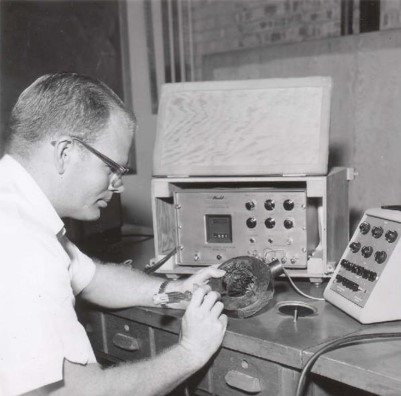 artillery unit to a medic unit where he spent most of his time in the dispensary caring for patients. However, he would often volunteer to go with the battalion for field exercises, some of which provided lessons that lasted a lifetime.
artillery unit to a medic unit where he spent most of his time in the dispensary caring for patients. However, he would often volunteer to go with the battalion for field exercises, some of which provided lessons that lasted a lifetime.
“My most memorable experience was when the battalion was sent for training to the Mountain and Cold Weather Command high up in the mountains to the west of Colorado Springs,” Eckelman said. “I spent two months learning mountain climbing and how to carry injured men down a mountainside. To this day, I feel that the mountain climbing training I received and the corresponding experiences made my time in the service worthwhile.”
When Eckelman’s time in the U.S. Army ended in 1955, he could have become a chicken farmer or maybe owned a dog kennel, but the government’s offer to service members of $5000 to go to school gave him a new career path.
“When I got out of the Army, Purdue had a program down in Columbus, Indiana, where I am from, so I signed up down there to go to school for the first year, and then three or four people I got to know well there said they were going to come to Purdue,” Eckelman recalled. “Purdue was far away then, but we all came up here and got started. After two years of chemical engineering, I decided that wasn’t what I really wanted - to sit tight in a chem lab all day, so I went and talked to Burr Prentice and he told me about wood products and everything that went along with it. I graduated in 1959 and I had a little money left at that time, so I looked at going on to graduate school.”
Eckelman stayed for a master’s (1962) and PhD (1968) and eventually became part of the faculty, a position he held from 1968 until his retirement in 2018.
For his first graduate school project, Eckelman worked with Dr. Stan Suddarth to build a rustic lecture hall building in Lost Lake, Wisconsin, where Forestry and Natural Resources students would go for summer training.
“Stan had designed it and I was basically given the job of going up and building it,” Eckelman said. “I went there and engaged two other guys up there and we put it up. When I came back, Stan had another project that he had gotten with the Forest Products Laboratory which had to do with a weight measuring device to be used in a dry kiln. That provided money to go on further and, when I finished that, there were other things I can’t even recall now. There was a temporary professor program I was part of at one time as well.”
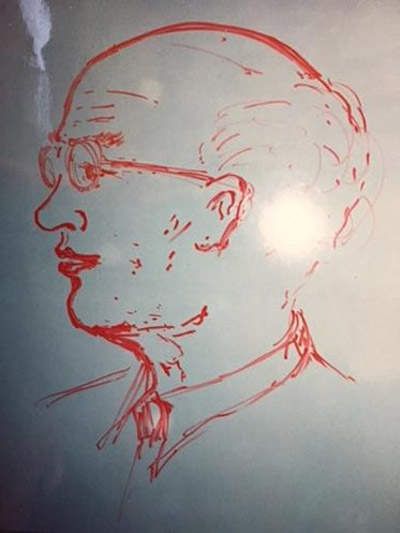 Eckelman continued to work with Suddarth on a variety of structural engineering projects, but also branched out to study computer analysis. He applied the principles of structural engineering to furniture and developed a computer program that could analyze the stresses on a variety of materials to test chair strength using the concept of semi-rigidity. That program was later passed along to individuals in several different countries from South Africa to Australia.
Eckelman continued to work with Suddarth on a variety of structural engineering projects, but also branched out to study computer analysis. He applied the principles of structural engineering to furniture and developed a computer program that could analyze the stresses on a variety of materials to test chair strength using the concept of semi-rigidity. That program was later passed along to individuals in several different countries from South Africa to Australia.
“I spent at least a full year working on a computer program to analyze structures that would deal with what are called semi-rigid joints,” Eckelman explained. “I then started working a lot with furniture. Then Jerrold Winandy graduated (BS 1976, MS 1978) and went to work for General Services Administration in Washington and he told them about the program at Purdue. It was a unique time in history because at that time, GSA bought all of the furniture for the government. Furniture manufacturers built it to the specifications that were given by the federal government and, as a result, everything looked like it had been manufactured in about 1920. What the government really wanted to do was to be able to buy furniture on the open market, but, in order to do that, they had to know how good the furniture was that they were buying. So, at that point, I got a grant from them to study furniture.”
What started with institutional furniture, or standard items used in government office buildings, eventually led to projects on air traffic controller chairs, military cots and library chairs over the years.
“I had one of my greatest days in Washington early in the project when the official I was standing with was telling all of the furniture manufacturers who were gathered for this meeting how we were going to grade furniture and develop standards for the open market,” Eckelman shared. “I could listen to the mumbling in the audience and tell that it just wasn’t going to work, so I got up and gave a different presentation, much to the chagrin of the GSA, and I told them what we were going to do. They knew how to make furniture, so we were going to get furniture from them, we were going to apply tests to it and then we would divide it into low, medium and high grades of furniture. They all took quite well to that.
“We did an enormous amount of testing of furniture that was provided by the various manufacturers. The first thing that came out of that was a performance test method and established standards for institutional furniture, which was furniture the government could use anywhere. You had three levels, so you could decide which level of performance you wanted and where it might go.”
Air traffic controller chairs provided a new challenge. These rolling office chairs are “subjected to some of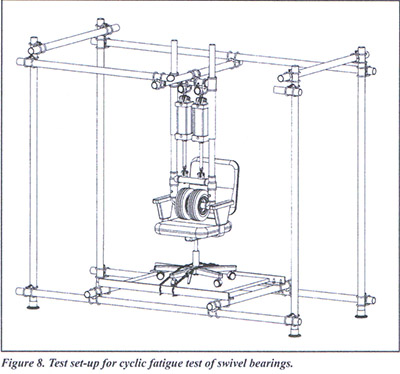 the worst conditions you can ever imagine.” Eckelman traveled to the control tower for O’Hare Airport in a little town south of Chicago and watched workers perform the stressful job of sitting intently, watching the screens of all of the aircraft going east and west and monitoring the aircraft so there were no collisions.
the worst conditions you can ever imagine.” Eckelman traveled to the control tower for O’Hare Airport in a little town south of Chicago and watched workers perform the stressful job of sitting intently, watching the screens of all of the aircraft going east and west and monitoring the aircraft so there were no collisions.
“Things often get very tense, and then other people come in to help. They bring in chairs, they sit on the arms of the chair and fling the chairs backward violently afterwards,” Eckelman said. “So I did tests on everything and came up with performance tests and standards for the air traffic control chairs. Then came military cots, which have a lot of problems. One of the big problems is that people sit on the end with the cot under their legs and then they can’t walk. I tested those and made performance standards for them. Then the American Library Association wanted standards developed for library furniture and chairs, so I worked on that with a couple of experts in that organization and came up with performance tests and standards for that.”
Eckelman applied the computer analysis program he had written to several furniture companies and came up with ways that they could improve their furniture. In 2003, Eckelman wrote a textbook “Product Engineering and Strength Design of Furniture.” He later developed short courses for industry personnel and a university class to share his knowledge.
Eckelman was a part of many other projects over the years. He worked on modular building construction in underdeveloped countries, creating plans for buildings that could be shipped to disaster areas and put together without tools using dowel joints, which could be modified later as resources became available. He advised furniture manufacturers on how to improve their products and their performance. He also worked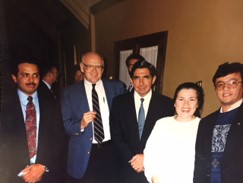 with researchers in Iran to demonstrate how the load capacity of shelves constructed of particleboard could be increased through the use of proper end connections.
with researchers in Iran to demonstrate how the load capacity of shelves constructed of particleboard could be increased through the use of proper end connections.
All told, Eckelman has been part of nearly 200 publications covering diverse topics from materials to case construction and joints to computer analysis, performance testing, furniture production, structural analysis, school furniture and small building construction.
Professor Jerzy Smardzewski, head of the Laboratory of Furniture Design and faculty of Forestry and Wood Technology at the Poznan University of Life Sciences in Poland, has never met Eckelman in person, but has been impacted by his work and his students.
“When I first read CODOFF: Computer Design of Furniture Frames by Dr. C.A. Eckelman, I was delighted that the experiences of carpenters and ebonists could be represented with tensors and matrices,” Smardzewski said. “It has become my great passion and publications and books by Dr. Eckelman were my greatest inspirations. In professional practice, we always refer to those who were the first to make a significant discovery or start a new chapter in science. In this sense, Professor Eckelman is always present in my scientific life. He was not my teacher, but I had professors who modeled themselves on his work, models and presentations. I also met exceptional people who had contact with Dr. Eckelman through FNR. All of them had an impact on changing the reality of their surroundings. They inspire, surprise, motivate and constantly help young adepts of science.”
Dr. Eva Haviarova (PhD 2000) joined Eckelman’s team as a graduate student in the late 1990s and continued his work with furniture design. She eventually took over teaching his Strength Design of Furniture course as well as the role of manager and director of the Wood Research Laboratory at Purdue. She also collaborated with Eckelman on a variety of projects until his retirement.
Haviarova came up with a way of building furniture that was simple yet resulted in very durable products, including the use of round mortise and tenon joint construction. She met with the Minister of Education in Costa Rica and other decision makers, helped assess their existing furniture and then created prototypes of wooden school furniture for children in developing countries, including projects in Jamaica, Uganda and Afghanistan. Funding came from a variety of sources, including churches and other non-profits who supported the work in their communities.
“I was encouraged to work on meaningful projects where I could use my resourcefulness and grow in new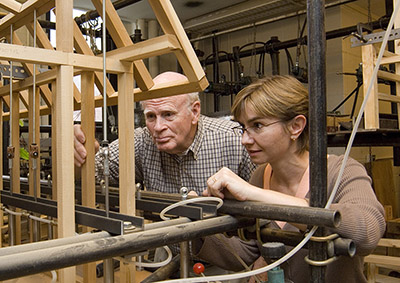 multidisciplinary areas,” Haviarova, an FNR faculty member since 2001, said of her work with Eckelman. “In addition, Dr. Eckelman created an environment where our international research team could bond and create lifelong collaborations. I am grateful for his mentorship and thankful for my successful career.”
multidisciplinary areas,” Haviarova, an FNR faculty member since 2001, said of her work with Eckelman. “In addition, Dr. Eckelman created an environment where our international research team could bond and create lifelong collaborations. I am grateful for his mentorship and thankful for my successful career.”
From 1989 to 1997, Eckelman served on FNR’s graduate committee, acting as its chair from 1992 to 1996. Under his leadership, the department expanded its graduate enrollment from 54 to 81 students. One way he did so was by striving to diversify the graduate program by making it international in its scope. Eighty percent of the students for whom Eckelman served as major advisor were international students.
“Graduate students were funded by the department and the funding for those students tended to be assigned to specific individuals and stayed with them. Therefore we had faculty in the department who were left out and didn’t have any graduate students,” Eckelman explained. “The faculty member who had the role before me got some money loosened up and then I came in and started giving money out and getting graduate students. As a result, we brought in many foreign graduate students. We spread the money around the department and became much more diverse.”
In a 2003 nomination for Dr. Eckelman to receive the Purdue School of Agriculture’s Outstanding Graduate Educator Award, Dr. Rob Swihart, then department head, further explained Eckelman’s impact on the graduate program.
“Dr. Eckelman has had a profound and lasting influence on graduate education,” Swihart said. “His expertise in wood technology has provided valuable instructional opportunities for graduate students at Purdue for over three decades. During that time, his exemplary behavior and scholarly productivity have demonstrated to students the qualities necessary for success in higher education. His dedication to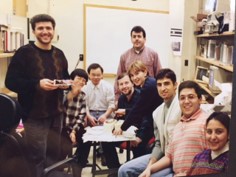 graduate education has been unwavering and selfless. His legacy includes a vibrant and diverse graduate enrollment in our department and a new generation of professionals in wood science and technology who are active around the world. His commitment to graduate education epitomizes the best in higher education.”
graduate education has been unwavering and selfless. His legacy includes a vibrant and diverse graduate enrollment in our department and a new generation of professionals in wood science and technology who are active around the world. His commitment to graduate education epitomizes the best in higher education.”
Federico Picado, an instructor in wood technology at the Costa Rica Institute of Technology, sent Eckelman a letter in the early 1980s asking about coming to Purdue as a graduate student. Eckelman sent a response to Picado, despite having little knowledge about Costa Rica. Picado came to Purdue to complete a master’s degree in 1988 and a PhD in 1994, sparking several Costa Rican students to follow suit.
“It is almost impossible to summarize Dr. Eckelman’s influence and contributions to all of us,” Picado, now a retired professor, said. “He was more than our academic advisor, he was also a mentor, a leader, a friend and a lot of times our family. Our families were also influenced by him and he always helped when we had problems or emergencies. To think that everything began with a letter I sent to him back in 1981 or 82, written down with grammar errors and so on. Just before that historical moment, a paper written by him was given to me, which caught my attention and interest in his area of research. I didn’t know where Purdue was located. It turned out that about six or seven weeks later I received a mail package with a letter and a group of papers written by him … the rest is history.
“We were just a group of young professors from Costa Rica eager to pursue graduate studies and bring knowledge and experience to our country, which we did. Most of us took classes in the school of industrial engineering, management, civil engineering and statistics. Carl supported and approved our plans of study based on our needs and goals. I recall a moment I had with him back in August 1994, just a couple of days before my trip back to Costa Rica. I gave him my special thanks and appreciation for all his help and support and suddenly he stopped me and said, ‘Federico, you don’t have to thank me, just promise me one thing: what I have done for you, do it for somebody else in Costa Rica.’ And that is precisely what I tried to do.”
Between 1988 and 1999, six more students came from Costa Rica to study in the FNR Wood Research Lab and earn graduate degrees.
- Oscar Gamboa (MS 1993)
- Jorge Acuña (PhD 1996)
- Marcos Moya (PhD 1996)
- Marvin González (PhD 1996)
- Rafael Serrano (MS 1996, PhD 1999 under Dr. Dan Cassens)
- Carmen Madriz (MS 1997)
- Aldo Ramírez (PhD 1998)
“Many times I heard Dr. Eckelman, my advisor, comment on how one person’s actions can make a big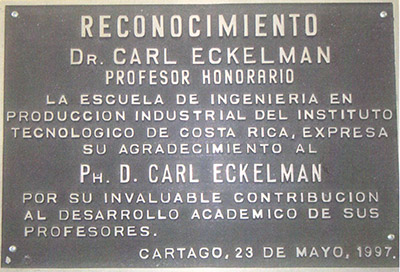 difference,” Ramirez said in his dissertation. “Dr. Eckelman is one of those persons: he has made an enormous difference in the lives of many students like myself. He has provided us with guidance, support, friendship and the opportunity to pursue our goals of higher professional development. Muchas gracias, don Carlos.”
difference,” Ramirez said in his dissertation. “Dr. Eckelman is one of those persons: he has made an enormous difference in the lives of many students like myself. He has provided us with guidance, support, friendship and the opportunity to pursue our goals of higher professional development. Muchas gracias, don Carlos.”
Madriz is still part of the faculty at the Institute of Technology, which presented Eckelman with its first honorary professor degree in 1997. Gonzalez is now an associate professor at the College of Charleston.
“We trained eight members of the faculty down there,” Eckelman said. “Four of those became trustees of The Institute of Technology. It just emphasizes that one individual like Federico writing that letter could cause such immense change.”
Henry Quesada (MS 2001, PhD 2004), now assistant director and program leader for Ag and Natural Resources at Purdue, first met Eckelman in 1998 when he visited Costa Rica Tech with Dr. Rado Gazo, Haviarova and former FNR department head Dennis LeMaster.
“I had heard about him from other Costa Rica Tech professors who had come to Purdue to pursue graduate degrees and always referred to Dr. Eckelman as one of the kindest human beings,” Quesada explained. “I decided to contact him to come to Purdue to pursue my own graduate education under his wing. After I contacted him, he recommended that I continue to work with Dr. Gazo as he was a new professor and needed graduate students, however I kept Dr. Eckelman on my MS and PhD committees. During my time at Purdue, he was always there, providing advice and sharing his life stories. He loved to chat about the economy, sports, politics and of course be informed about the many students he graduated from Costa Rica. His door was always open and he was very easy to reach and engage with.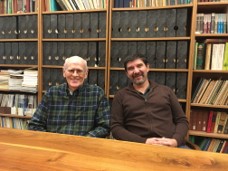
“People wanted to be like Dr. Eckelman. They wanted to follow him because he represents values such as kindness, compassion, perseverance, hard work, discipline, empathy and creativity. He did not mentor students based on his degree or position at the University. Instead, his mentorship style was based on care, advice, examples, motivation and getting you inspired. That is true mentorship. He is one of the most wonderful human beings that I have had the honor to meet. He trusted Costa Ricans to come to Purdue to work in his program. He gave us an opportunity to believe and imagine that we could do great things in life. His impact will go forever through many generations.”
Eckelman’s impact extends beyond Costa Rica and across the globe thanks to graduate students from Turkey, Malaysia, Taiwan and China, many of whom now serve in faculty and other administrative positions.
Yusuf Erdil (MS 1998, PhD 2002) is now a professor at Mugla University (Kötekli, Türkiye). While in Eckelman’s lab he worked on an engineered wood association project on plywood and OSB (Oriented strand board) properties for his thesis before completing his dissertation on “Integrated Product Engineering and Performance Testing of Furniture.”
“Dr. Eckelman was the FNR experience and the role model for me,” Erdil said. “He had a robust awareness of diversity and inclusion when these concepts were not as popular as today. He gave me a chance to experiment and learn while he was making invisible but firm touches to keep me on track. He was very experienced, intelligent and well-known, yet very down-to-earth professor. He was always kind and friendly but serious about the job. As an advisor, he was calm and helpful, yet open to discussion, always giving room for improvement and creativity.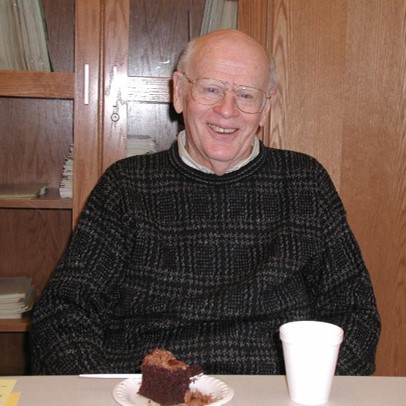
“Thanks to the projects carried out with him, I have had a chance to gain immense experience academically. As a matter of fact, the Purdue experience with Dr. Eckelman made me the earliest-ever associate professor and full professor in the history of my university. I have had a chance to be a lead scientist in my career, while supporting many undergraduate and graduate students like he did. I have kept in contact with many of my colleagues and proudly represented FNR in my country and the world. As the years go by, I understand more and more how the Purdue FNR experience and being a student of Dr. Carl A. Eckelman was valuable for me.”
Dr. Jilei Zhang, a professor in the Department of Sustainable Bioproducts at Mississippi State University, completed his PhD under Eckelman in 1995 and said Eckelman was involved with students in and out of the classroom and lab.
“Dr. Eckelman as a professor still got his hands dirty, working with us on research projects such as setting up testing equipment or writing a computer program. As an advisor, he always told us to focus on fundamentals and pay attention to details,” Zhang said. “Carl’s caring for students was not only like a professor, but also like a parent. I remember every Thursday afternoon he took us to the university cafeteria across the road from the lab and we picked our favorite cookies and soft drinks, sat around the table and chatted with Carl. I somehow carry on this tradition with my graduate students.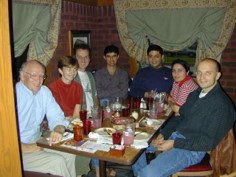
“My time and experience as a graduate student in FNR made me want to pursue a university research and teaching career and become a professor like Dr. Eckelman. I started my university faculty career in 1998 and during my first five years at Mississippi State, I actively worked with Dr. Eckelman and his graduate students on several furniture engineering research projects. Our efforts yielded eight journal articles published. During that time, I visited Dr. Eckelman once a year to continue seeking his wisdom and support. His advice and continuing support as a mentor significantly impacted my early academic career, enhancing my confidence in pursuing advancement in the academic world.”
Eckelman’s encouragement also impacted Dr. Hongtao (Peter) Zhou, who earned his PhD in 2008. Zhou is the director and vice dean of the Innovation Field at the College of Design and Innovation (D&I) at Tongji University in Shanghai.
“Dr. Eckelman is a great friend and senior member of the wood lab family,” Zhou said. “He is someone who cares about real world challenges. He encouraged me to be myself. He gave me freedom and the freedom of exploration and research contributes a lot to my creative career. His commitment to matters of the time encourages me to move forward and his humor is always there in daily communications to tell me that life is more important than work.”
Dr. Jorge Acuna (PhD 1996), who is now retired after his career at the Costa Rica Institute of Technology, said Eckelman encouraged him personally and professionally.
“Dr. Eckelman has been a very special person in my life,” Acuna said. “From a personal point of view, he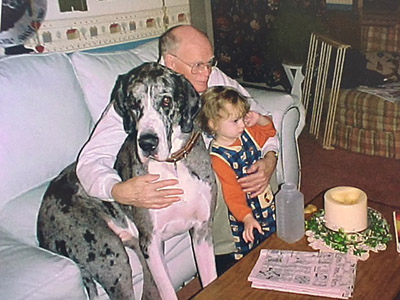 was always worried about my family and how they were. As a research advisor, he was outstanding. His advice in difficult moments of the research development was always very accurate and on time. Even though his expertise was in the wood industry, he was also worried about my performance in the different activities I did and the different courses I took from the school of Industrial Engineering. The extension activities and visits to the Indiana wood industries were very important for my knowledge. Each visit to Jasper wood processing industries, applying engineering concepts was a wonderful experience of learning and providing a clear understanding of how the relationship between industry and university is very important for both sides for reaching productivity and quality goals.”
was always worried about my family and how they were. As a research advisor, he was outstanding. His advice in difficult moments of the research development was always very accurate and on time. Even though his expertise was in the wood industry, he was also worried about my performance in the different activities I did and the different courses I took from the school of Industrial Engineering. The extension activities and visits to the Indiana wood industries were very important for my knowledge. Each visit to Jasper wood processing industries, applying engineering concepts was a wonderful experience of learning and providing a clear understanding of how the relationship between industry and university is very important for both sides for reaching productivity and quality goals.”
Martin Quanci (MS 1988), who studied the mechanical, physical and anatomical properties of fast grown timber under Dr. John Senft, said it was Eckelman’s efforts to embrace technology that stuck out to him.
“Carl Eckelman was a genius with furniture testing and loved to bring in foreign students for graduate work,” said Quanci, who is self-employed as a sawmill engineer at Mill-Quality Equipment & Designs, LLC in Chillicothe, Ohio. “He also latched onto the idea of using simple and inexpensive personal computers for graduate student work. This was when the first IBM PCs came on the market and they were expensive. Carl championed the use of Commodore 64s, computers the foreign students could easily acquire in their home countries.”
Jim Bradtmueller (MS 1987, PhD 1992) began working in the Purdue Wood Research Lab part time in 1983 as an undergraduate student in agricultural engineering. He went on to complete his master’s degree under Eckelman’s supervision, studying “Application of the Finite Element Method to the Analyses of the Front Rail Systems of Upholstered Furniture.” Bradtmueller went on to work in the engineered lumber industry for Trus Joist MacMillan and Weyerhaeuser before retiring after a career as an assistant and associate professor of construction management at Northern Kentucky University.
“Carl’s methods of testing mechanical fasteners that are used to make furniture joints and his techniques for fatigue testing furniture were both innovative and effective,” Bradtmueller said. “Additionally, Carl had developed and used matrix structural analysis through his program CODOFF (Computer Design of Furniture Frames) to structurally analyze furniture assemblies. At that time, I highly doubt if anyone else in the world was using a full-blown, automated structural engineering approach to analyze the internal forces, moments and stresses occurring in furniture frames subjected to external loads. As a furniture researcher, Carl was ahead of his time and it made me want to pursue an MS in Wood Science at the Wood Lab.
“I had the opportunity to work for or learn from all of the professors that were in the Wood Research Lab at the time and felt fortunate to be at the Wood Lab during a period when very active and highly diverse research was being conducted. Graduate students and visiting scientists were there from all over the U.S. and other countries and we all collaborated well together. Carl was very considerate of his students who were working and studying at the Wood Lab. He often would have us over for dinner with his family or take us out for pizza, which really helped us get to know and appreciate each other. My experiences and research made me very well prepared for all of the various positions that I held after graduation.”
Eckelman retired in 2018 to take care of his wife, Sally, before her eventual passing. These days, he writes lines of rhyme, completes two 100-piece jigsaw puzzles a day online (without turning the pieces), and writes and does other activities left-handed to keep his brain active. He also spends time with his family, his son, two daughters and four grandchildren, including a recent trip to Disneyworld.
writes and does other activities left-handed to keep his brain active. He also spends time with his family, his son, two daughters and four grandchildren, including a recent trip to Disneyworld.
On August 27, 2022, Eckelman and nearly 60 other members of the Wood Research Lab family got together for a reunion on campus. Many of the individuals who studied under Eckelman will join him virtually on zoom as he celebrates his 90th birthday on Feb. 14. It will be the celebration of years well spent investing in the lives of others and the future of the wood products industry.
“The strange thing is that with a lot of the work that I did, there was a lapse of about 40 years before people started picking it up and going with it, but a lot of them have elaborated on it, going way beyond what I started,” Eckelman said. “The Purdue Wood Research Lab is still going. It’s still progressing and there are very good people there. It is fortunate that Eva came along when she did and I hope it continues to grow and continues on. There is much to be done yet."
 Dr. Carl Eckelman with his cat
Dr. Carl Eckelman with his cat 





